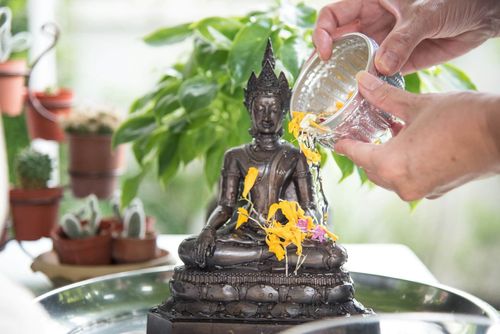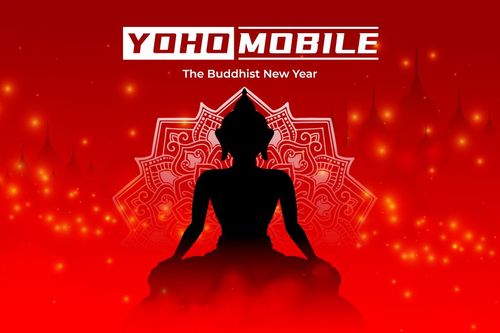Did you know there’s another New Year celebration happening right now, depending on where you are? We’re talking about the Buddhist New Year of 2024, a vibrant tradition observed on different days during the year, with some falling in April.
Each culture celebrates it differently, and the dates can differ from one place to another. For instance, Theravada Buddhists, found in Southeast Asia, usher in the year with a three-day celebration following the April full moon. Meanwhile, Mahayana Buddhists in Korea, China, and Vietnam set their sights on the January full moon. And Tibet’s Losar is full of color and joy in March. In short, the Buddhist New Year is a time for fresh beginning, reflection, and joyful reunions.
You Might Also Like: Mount Everest Day: 7 Thought-Provoking Questions
What Is Exactly The Buddhist New Year?
In spite of having many different names and dates, it is the start of the new year on the traditional lunar Buddhist calendar. A time to celebrate a fresh start and reflect on Buddha’s teachings. It’s also an occasion where people visit temples to make offerings, participate in blessings, and strive to strengthen good karma.
For instance, in Theravada countries, water rituals symbolize the washing away of negativity from the past year, while Mahayana celebrations remember Buddha’s journey towards enlightenment. Overall, for Buddhists, the New Year is about starting afresh, setting intentions, and committing to being mindful in the coming year.
What Makes Dates Vary?
Dates vary because Buddhists follow a lunisolar calendar, which combines the cycles of the moon and sun.
It’s not like the Gregorian calendar used in most countries, the lunisolar calendar doesn’t perfectly align with the solar year, so the New Year falls on different dates. Typically, it falls in April, but for some countries, it’s on the full moon in January.
More than just marking a date on the calendar, the Buddhist New Year holds significant meaning to honor their faith. They use rituals and ceremonies to show their respect, acts of merit-making, visits to temples, offerings, and water ceremonies symbolizing purification and a fresh start.
Related: What is the Spiritual Meaning of the Summer Solstice?
How Many Countries Observe the Buddhist New Year?
Many places with significant Buddhist populations celebrate this special event: Thailand, Sri Lanka, Cambodia, Laos, Myanmar, Nepal, Bhutan, Tibet, Bangladesh, and parts of India (mostly in regions where devotees gather in large numbers, like Ladakh, Sikkim, and parts of the North East)
These are just a few examples. There are plenty more communities that have their own Buddhist New Year customs. Likewise, festivities may differ in how they’re observed, their customs, and when they occur, depending on the place.
Do Buddhists observe the Chinese New Year?
Buddhists do not typically observe Chinese New Year as a religious holiday. Though widely observed by Chinese people, including Buddhists, its roots lie in Chinese cultural traditions rather than Buddhist teachings.
Chinese New Year is about family gatherings, feasting, and fun, not precisely Buddha teachings. Buddhist New Year, on the other hand, is more focused on spiritual renewal and follows different dates based on their customs. However, some Buddhist temples might indeed have special events during Chinese New Year, and some Buddhists may include Buddhist practices in their celebrations. Overall, while not strictly a holiday for them, Chinese New Year is enjoyed by many, including Buddhists, and may hold some Buddhist influences depending on the context.

Are Buddhist New Year And Vesak The Same?
Although such events are related and equally important for Buddhism, they aren’t the same.
On one hand, the Buddhist New Year signals the beginning of the new year in its respective lunar calendar and is known by different names. People often visit temples and perform rituals on this festive occasion, and practices are focused on reflection, renewal, and accumulating merit.
On the other hand, Vesak is the holiest day in Mahayana Buddhism, which commemorates three significant events in the life of Buddha (birth, Nirvana, and death). It is said these events occurred on the same day, though some other traditions celebrate them on separate days. Typically, it is observed on the first full moon of May, or in June if it’s a leap year. This means the exact date varies from year to year.
Are Buddhist And Mahayana New Year The Same?
They are related but not necessarily the same, as Mahayana is just one of the major branches of Buddhism.
Its date and customs may vary depending on the particular Mahayana tradition or cultural context, with some celebrating it on January 1st and others on the full moon of January. As we mentioned earlier, Buddhist New Year marks the beginning of the new year in several Buddhist calendars. It is also observed in countries where this religion has a great impact. Followers from different traditions like Theravada, Mahayana, and Vajrayana come together to celebrate this event.
In short, the Mahayana and Buddhist New Year are closely related. The first focuses mainly on the New Year celebrations within its Buddhist branch. The latter includes celebrations that are observed by Buddhists from various traditions worldwide.
When Is The Buddhist New Year in 2024?
There is no fixed date as different regions celebrate it based on their own Buddhist lunar calendar system. Although it usually takes place from January to April. For example, in the majority of Theravada Buddhist countries, it is observed in April.
In 2024, the Buddhist New Year will likely be celebrated as follows:
- Songkran Thailand: from April 13 to April 15
- Chaul Chnam Thmey in Cambodia: from April 13 to April 16
- Aluth Avurudda in Sri Lanka: on April 13 to 14
- Nepal Sambat’s date can vary, but it often aligns with the first day of the Nepali lunar calendar, which usually falls on April 14
- Thinyan in Myanmar: from April 13 to April 16
- Puthandu in Tamil Nadu, India: April 14
You Might Also Like: 5 Travel Tips for Holiday Happiness
How will devotees from different cultures celebrate the Buddhist New Year in 2024?

No matter the specific day when they take place, Buddhist New Year is a time of reflection and renewal. In temples, prayers are offered for a peaceful closing of the year and a hopeful start to the new one. Devotees take part in a ceremonial cleansing of Buddha statues. Others pay their respects to these and other divine beings with lit candles. The fact that they also clean their homes symbolizes a fresh start. Such celebration extends to friends and relatives with warm greetings and shared meals.
You Might Also Like: Which is the Best eSIM for India? Your Ultimate Guide

Visa Vectores by Vecteezy

